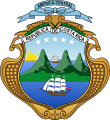
Central America is commonly said to include Guatemala, Belize, El Salvador, Honduras, Nicaragua, Costa Rica, and Panama. This definition matches modern political borders. Central America begins geographically in Mexico, at the Isthmus of Tehuantepec, Mexico's narrowest point, and the former country of Yucatán (1841–1848) was part of Central America. At the other end, before its independence in 1903 Panama was part of South America, as it was a Department of Colombia. At times Belize, a British colony until 1981, where English instead of Spanish is spoken, and where the population is primarily of African origin, has been considered not part of (Spanish-speaking) Central America.

The Federal Republic of Central America was a sovereign state in Central America which existed from 1823 to 1841. Originally known as the United Provinces of Central America, the democratic republic was composed of the territories of the former Captaincy General of Guatemala of New Spain.
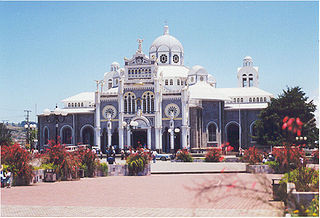
Cartago is the head city of Cartago canton of the Cartago Province, and is composed of the Oriental and Occidental districts as stated in the administrative divisions of Costa Rica. It was the capital of Costa Rica from 1574 to 1824.

The national flag of Costa Rica is based on a design created in 1848 and consists of two blue stripes, two white stripes, and a central red stripe which is twice as wide as each of the other four. The civil flag omits the coat of arms seen on the state flag, since the state variant is only permitted to be used by the government.

The flag of Nicaragua was first adopted on September 4, 1908, but not made official until August 27, 1971. It is based on, and inspired by, the flag of the Federal Republic of Central America and flag of Argentina.
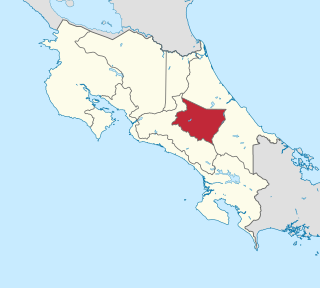
Cartago, which means Carthage in Spanish, is a province of central Costa Rica. It is one of the smallest provinces, however probably the richest of the Spanish Colonial era sites and traditions.

Liberia is a district and the largest city in the Guanacaste Province of Costa Rica, located 215 kilometres (134 mi) northwest of the national capital, San José. Part of the Liberia canton, it is a major center for the country's tourism industry.
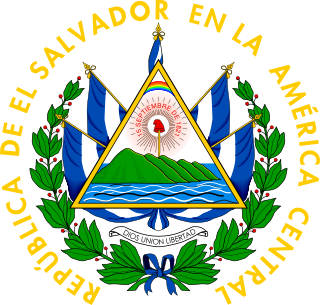
The coat of arms of El Salvador has been in use in its current form since 15 September 1912.
José Francisco de Peralta y López del Corral was a Costa Rican priest and politician. He was born in Cartago, Costa Rica, the son of José María de Peralta y La Vega and Ana Benita de Nava López del Corral. Peralta attended the University of León and was ordained as a pastor in León, Nicaragua in 1812. He was named a parish priest for the village Olocuilta, El Salvador.

The following is an alphabetical list of topics related to the Republic of Costa Rica.

Braulio Evaristo Carrillo Colina was the Head of State of Costa Rica during two periods: the first between 1835 and 1837, and the de facto between 1838 and 1842.

El Salvador became independent from Spain in 1821. It has produced its own stamps since 1867.

The Constitution of Costa Rica is the supreme law of Costa Rica. At the end of the 1948 Costa Rican Civil War, José Figueres Ferrer oversaw the Costa Rican Constitutional Assembly, which drafted the document. It was approved on 1949 November 7. Several older constitutions had been in effect starting from 1812, with the most recent former constitution ratified in 1871. The Costa Rican Constitution is remarkable in that in its Article 12 abolished the Costa Rican military, making it the second nation after Japan to do so by law. Another unusual clause is an amendment asserting the right to live in a healthy natural environment.
The Ochomogo War was a civil war fought in Costa Rica, the first in its history, and was fought shortly after the country became independent from Spain.

The Free State of Costa Rica was the name acquired by Costa Rica after its split from the Federal Republic of Central America in 1838 and until the proclamation of the First Costa Rican Republic in 1847.

The history of the Costa Rican legislature is long and starts from even before its formal independence from the Spanish Empire. Costa Rica is one of the world's oldest democracies, thus, its parliamentary history dates back several centuries.
The Second Political Statute of the Province of Costa Rica was issued on May 16, 1823 by the interim government and the Second Provincial Congress of the Province of Costa Rica. It was issued just after the Ochomogo War when the monarchist camp settled in Cartago and Heredia and headed by Joaquín de Oreamuno as its commander of arms, was defeated by the Republican side commanded by Gregorio José Ramírez and gravitated around San José and Alajuela.
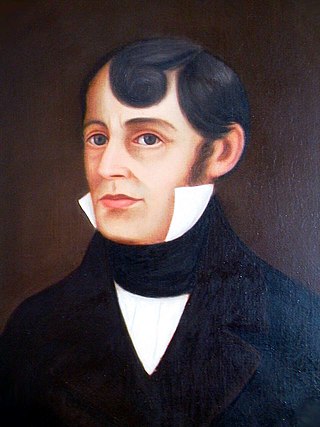
The Fundamental Law of the Free State of Costa Rica, sometimes called the Political Constitution of 1825, was issued on January 25, 1825 by the Constituent Congress of the State of Costa Rica and during a time the country was a formal member of the Federal Republic of Central America. It would function until it was abrogated by Braulio Carrillo Colina who in 1838 takes power in a dictatorial manner and issues on March 8, 1841 the Decree of Basis and Guarantees that will operate as a de facto constitution until the arrival of Francisco Morazán in 1844 who overthrew Carrillo and was temporarily restored.

The annexation of the Partido de Nicoya to Costa Rica is a historical event that refers to the incorporation of the territory of Nicoya to the State of Costa Rica, which occurred on July 25, 1824.







